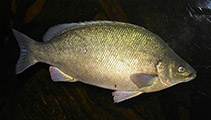Uploaden van uw Foto's en video's
Pictures | Google afbeeldingBidyanus bidyanus
Picture by Meyer, T.
Pictures | Google afbeeldingBidyanus bidyanus
Picture by Meyer, T.
Chinese Taipei (Taiwan) country information
Common names:
[No common name]
Occurrence: introduced
Salinity: freshwater
Abundance: | Ref:
Importance: | Ref:
Aquaculture: commercial | Ref: Liao, C.-I., H.-M. Su and E.Y. Chang, 2001
Regulations: | Ref:
Uses: no uses
Comments: First successful larviculture in Taiwan occurred in 1994 (Ref. 40297).
National Checklist:
Country Information: https://www.cia.gov/library/publications/resources/the-world-factbook/geos/tw.html
National Fisheries Authority:
Occurrences: Occurrences Point map
Main Ref: Liao, C.-I., H.-M. Su and E.Y. Chang, 2001
National Database: The Fish Database of Taiwan
Occurrence: introduced
Salinity: freshwater
Abundance: | Ref:
Importance: | Ref:
Aquaculture: commercial | Ref: Liao, C.-I., H.-M. Su and E.Y. Chang, 2001
Regulations: | Ref:
Uses: no uses
Comments: First successful larviculture in Taiwan occurred in 1994 (Ref. 40297).
National Checklist:
Country Information: https://www.cia.gov/library/publications/resources/the-world-factbook/geos/tw.html
National Fisheries Authority:
Occurrences: Occurrences Point map
Main Ref: Liao, C.-I., H.-M. Su and E.Y. Chang, 2001
National Database: The Fish Database of Taiwan
Common names from other countries
Classificatie / Names Lokale namen | Synoniemen | Catalog of Fishes(Genus, Soort(en)) | ITIS | CoL | WoRMS | Cloffa
> Centrarchiformes (Basses) > Terapontidae (Grunters or tigerperches)
Etymology: Bidyanus: A local name, "bidyani" in Australia, New South Wales.
Etymology: Bidyanus: A local name, "bidyani" in Australia, New South Wales.
Environment: milieu / climate zone / depth range / distribution range Ecologie
; zoet water benthopelagisch; potamodroom (Ref. 51243); diepte 10 - ? m. Subtropical; 10°C - 30°C (Ref. 2060); 29°S - 35°S
Verspreiding Landen | FAO regio's | Ecosystemen | Voorkomen | Point map | Introducties | Faunafri
Oceania: known only from the Murray-Darling River system, Australia. Range boundaries: Chinchilla (on the Condamine River), South Queensland, Bonshaw (on the Dumaresq River), northeastern New South Wales, Albury (on the Murray River), southeastern New South Wales, Seven Creek and Goulburn River, South Victoria.
Lengte bij maturiteit / Grootte / Gewicht / Leeftijd
Maturity: Lm ?, range 34 - ? cm
Max length : 40.0 cm SL mannelijk / geslacht onbekend; (Ref. 2906); common length : 30.0 cm SL mannelijk / geslacht onbekend; (Ref. 44894); max. gepubliceerd gewicht: 1.5 kg (Ref. 5259)
Max length : 40.0 cm SL mannelijk / geslacht onbekend; (Ref. 2906); common length : 30.0 cm SL mannelijk / geslacht onbekend; (Ref. 44894); max. gepubliceerd gewicht: 1.5 kg (Ref. 5259)
Adults are found in rivers, lakes and reservoirs, preferring fast-flowing waters of rapids and races and usually forming aggregations near the surface. Usually found below rapids and weirs (Ref. 44894). Feed on aquatic insects, mollusks, earthworms and plants. Temp.: 2-37°C. Maturity: F, 3 y and 34 cm SL; M, 23.3 cm SL. Spawning: summer (Nov.-Jan., 23-30°C water temp.), effect upstream migration. Fecundity: 500000 eggs per 1.8kg. Eggs: pelagic, 2.7-2.8 mm diameter. Hatching: 30 hrs at 26-27°C. Larvae: 3.6 mm at hatching. A good angling and food fish which has been increasingly utilized as an aquaculture species in farm dams throughout Australia (Ref. 44894).
Levenscyclus en paargedrag Maturiteit | Voortplanting | Paaien | Eieren | Fecunditeit | Larven
Upstream spawning migration in summer to areas behind the peak of the flood. Spawning commences late in the afternoon from the surface to a depth of about 4 m, where there is a flow over a gravel, rock rubble substrate. Considerable spawning activity happens at the water surface. A single female circles slowly to the surface with her head deep and several males participate in courtship and finally in fertilization (Ref. 2906).
Hoofdreferentie
Upload your references | Referenties | Coördinator | Medewerkers
Paxton, J.R., D.F. Hoese, G.R. Allen and J.E. Hanley, 1989. Pisces. Petromyzontidae to Carangidae. Zoological Catalogue of Australia, Vol. 7. Australian Government Publishing Service, Canberra, 665 p. (Ref. 7300)
Status op de Rode Lijst van het IUCN (Ref. 130435: Version 2024-2)
Gevoelig (NT) ; Date assessed: 13 February 2019
Gebruik door de mens
Visserij: commercieel; Aquacultuur: commercieel; sportvis: ja
FAO(Aquaculture systems: productie; ; publication : search) | FishSource |
Meer informatie
Population dynamics
Groeiparameters
Max. ages / sizes
Length-weight rel.
Length-length rel.
Lengtefrequenties
Massaconversie
Rekrutering
Abundantie
Groeiparameters
Max. ages / sizes
Length-weight rel.
Length-length rel.
Lengtefrequenties
Massaconversie
Rekrutering
Abundantie
Life cycle
Voortplanting
Maturiteit
Fecunditeit
Paaien
Spawning aggregations
Eieren
Ontwikkeling van de eieren
Larven
Larvale populatiedynamiek
Voortplanting
Maturiteit
Fecunditeit
Paaien
Spawning aggregations
Eieren
Ontwikkeling van de eieren
Larven
Larvale populatiedynamiek
Anatomy
Kieuwoppervlak
Brain
Otolith
Kieuwoppervlak
Brain
Otolith
Physiology
Body composition
Nutrients
Zuurstofverbruik
Zwemtype
Zwemsnelheid
Visual pigments
Fish sound
Diseases & Parasites
Toxicity (LC50s)
Body composition
Nutrients
Zuurstofverbruik
Zwemtype
Zwemsnelheid
Visual pigments
Fish sound
Diseases & Parasites
Toxicity (LC50s)
Genetics
Genetica
Heterozygosity
Erfelijkheid
Genetica
Heterozygosity
Erfelijkheid
Human related
Aquaculture systems
Aquacultuurprofielen
Kweeklijnen
Ciguatera cases
Stamps, coins, misc.
Aquaculture systems
Aquacultuurprofielen
Kweeklijnen
Ciguatera cases
Stamps, coins, misc.
Tools
E-boek | Veldgids | Lengtefrequentie Tool | Levenscyclus tool | Verspreidingskaart | Classification Tree
| Catch-MSY |
Speciale rapporten
Bekijk gegevens voor het houden in een aquarium | Bekijk Fact Sheets voor de soort | Bekijk Aquacultuur Fact Sheets
Download XML
Internetbronnen
Exoten/Invasieve soorten database | Aquatic Commons | BHL | Cloffa | BOLDSystems | Websites from users | Bekijk FishWatcher | CISTI | Catalog of Fishes(Genus, Soort(en)) | DiscoverLife | ECOTOX | Faunafri | Fishtrace | GenBank(genoom, nucleotide) | GloBI | GOBASE | | Google Books | Google Scholar | Google | IGFA World Record | MitoFish | Nationale databanken | Otolith Atlas of Taiwan Fishes | PubMed | Reef Life Survey | Scirus | SeaLifeBase | Tree of Life | Wikipedia(ga naar, zoek) | World Records Freshwater Fishing | Zoological Record
Estimates based on models
Fylogenetische diversiteitsindex (Ref. 82804): PD50 = 0.7500 [Uniqueness, from 0.5 = low to 2.0 = high].
Bayesian length-weight: a=0.01660 (0.00638 - 0.04320), b=2.99 (2.76 - 3.22), in cm Total Length, based on LWR estimates for this (Sub)family-body shape (Ref. 93245).
Trofisch niveau (Ref. 69278): 3.0 ±0.34 se; based on food items.
Weerstandsvermogen (Ref. 120179): Gemiddeld, minimale populatieverdubbelingstijd 1,4-4,4 jaar (tm=2-3).
Fishing Vulnerability (Ref. 59153): Moderate vulnerability (39 of 100).




